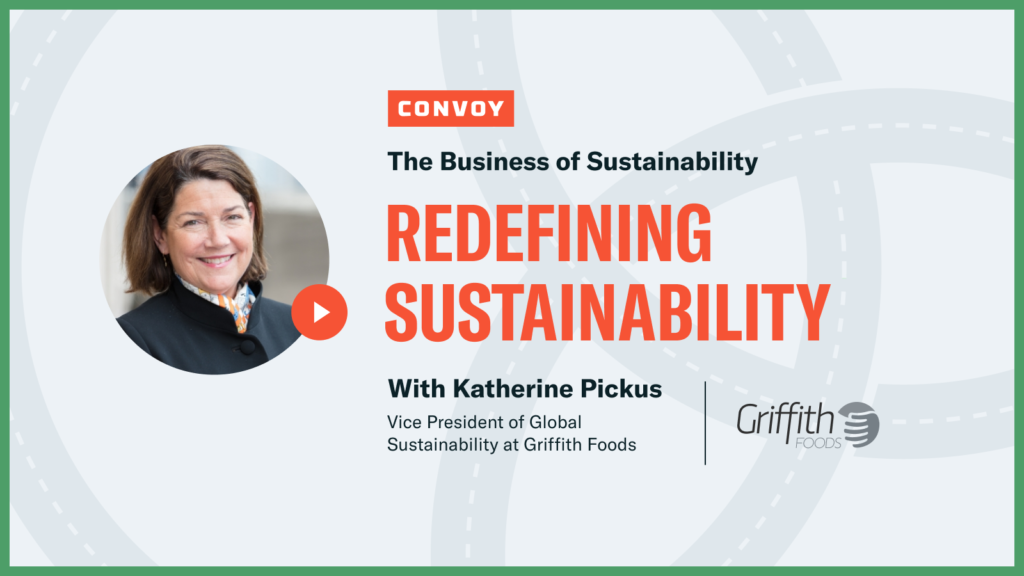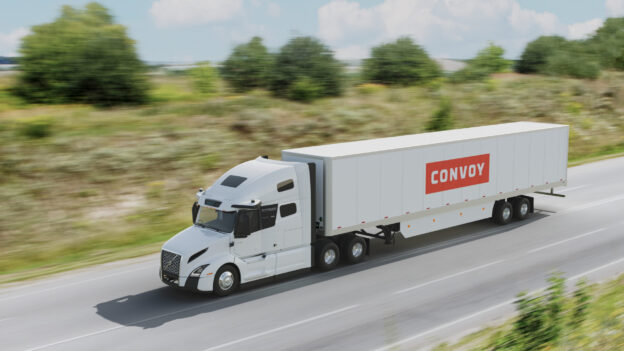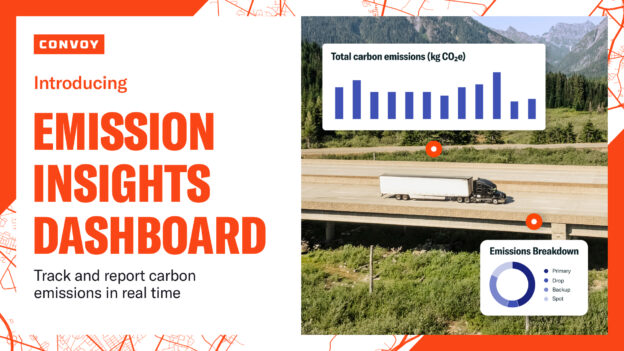Griffith Foods’ Katherine Pickus On Redefining Sustainability
Shippers, Sustainability • Published on September 22, 2020
In today’s global marketplace, there is no longer a question of whether a company can afford to have a sustainability mission. The space is moving so fast, we have moved well past the possibility of a sustainability goal and fast forwarded to how impactful an organization’s sustainability policies actually are. This is evolving so quickly because consumers are asking more and more questions about where a product comes from, what the environmental impacts are, and they want companies to be transparent about their business by sharing evidence of actions AND solutions.
To help us navigate these rapid developments, we invited Katherine Pickus, Vice President of Global Sustainability at Griffith Foods to share her thoughts on how to best integrate sustainability into an organization. Griffith Foods is a privately held global supplier to the food sector which has been in business for over a century sourcing spices and herbs. Katherine was brought on board one year ago to create and head their global sustainability efforts.

While Griffith Foods has always had a purpose-driven mission, the company’s sustainability actions had primarily operated in a silo prior to Katherine’s arrival. She resisted building a sustainability team because she wanted to embed it within the existing business versus it operating independently. Her mission was to put together an overarching plan to coordinate sustainability actions around the world. Some of the key takeaways from our conversation with Katherine include:
- How a company decides what its sustainability practices will look like: At Griffith Foods, spices and herbs are sourced and sold to the food sector. They have had opportunities to work with farmers over decades in growing chili peppers and sage and black and white pepper, etc. The sustainability aspect trends toward not just how does the company ensure the highest quality of ingredients, but how can they improve the farmers’ livelihoods and empower them to engage. (1:54)
- How to get a business to place value on sustainability: Have a clear purpose which comes from the highest levels of the company and maintain the same standards whether you are a public or private entity. Today’s companies place value on sustainability to create trust and transparency and keep pace with stakeholder expectations. Look at it as the ability to hold yourself accountable to make sure you are external facing in policies and practices. It’s important to not just discuss just what you do well, but also where you find challenges. (3:53)
- Why it is important to implement a materiality analysis at the outset: Conduct analyses with internal stakeholders probing the answers to your concerns, expectations, contribution to society, risks, where there are opportunities to create or preserve value, and how you can build trust in those efforts. Also conduct one externally by talking to people to find out what their expectations are of you and how your organization meets those expectations through practices and partnerships. A materiality analysis identifies the issues you want to tackle, which then leads to a sustainability framework, and from there you can create a roadmap for sustainability with key goals and metrics to share with customers and suppliers. The end goal is to have a really robust sustainable value chain which goes upwards and downwards to share with customers and suppliers to map your environmental, social, and governance performance. (5:00)
- How to organize sustainability within a company so it doesn’t become siloed: Start with a global corporate function and then invite organizations and individuals from within and outside the company to come to the table to tackle the issues you have identified. It is vitally important to project a global voice. Stakeholders who want to talk about your sustainability plan seek to understand it is not just coming from the top down. You have to demonstrate how it is living and breathing in all parts of the organization to work in unison for a concerted effort. (8:51)
- Consider establishing a creative governance structure for your sustainability efforts: Griffith Foods reorganized the board of directors to include a sustainability advisory council made up of leading individuals from outside the company and created new committees of the board aligned with the five areas of focus of its sustainability strategy. Their input at the table helped Katherine to create a 2030 sustainability plan which drives a cohesive framework around the organization. (10:10)
Watch the video or read the transcription below.
Jennifer: Can you first tell us a little bit more about your role and responsibilities as the VP of global sustainability at Griffith Foods?
Katherine: I’ve been in this role now for just over a year. I came to support the CEO, the chairman, and a really wonderful group of people who are looking to really form a robust sustainability strategy for our company that has been built on purpose for over 100 years. And so, it’s my job to mind the value chain for both risk as well as opportunities, create a framework, and a strategy, and some measurements that can really drive long term progress.
Jennifer: What did sustainability look like before you joined?
Katherine: There were some really great initiatives, but they were working in silos. [2:00] So, what I’ve been trying to do is kind of put together this kind of overarching plan that helps coordinate our actions around the world. Now, I didn’t share too much about who Griffith is, but Griffith is a privately held global supplier to the food sector. We source different ingredients like spices and herbs, we bring them in house, and we create these nutritious and delicious blends that we sell in the food sector. So, as you can imagine, they have experience throughout their many decades of being in business. You know, opportunities to really work with farmers, and that was probably the most exciting area of work in progress on the sustainability journey. They have been working with suppliers or farmers of chilies and sage, and black pepper, white pepper to really ensure quality of ingredients for their products but also with an eye to improving farmer’s livelihoods and what they could do to really empower and engage their training and the application of different standards either through the rainforest alliance certifications or their very own Griffith sustainably sourced criteria how they can improve the lives and the content of what they were sourcing.
Jennifer: And you mentioned that Griffith has been a purpose driven company for the past couple hundred of years, how does the business value sustainability to want to incorporate it so early on into their business?
Katherine: Yeah. You know, its very interesting, you know, the purpose is we bring care and creativity [4:00] to the rest of the world and this vision comes from the highest level of the company and what we’re seeing as a supplier, as many companies are today, whether you’re publicly traded or you’re privately held, the same standards are being asked of you. You know, we just discussed a little bit about the surveys that we’re being asked to perform, you know, EcoVadis, or how does a company, even like Mars that is not publicly traded, how do they do the data and sustainability mix. They do it because this effort to create trust and transparency and keep pace with stakeholder expectations has never been more important. And so, we see the ability to hold ourselves accountable, to make sure that we are external facing in our policy and our practices to discuss, not just what we do well, but also where we find challenges. You know, part of what we’re trying to do is through this effort, and one of the first things I did when I came to the company is we did a materiality analysis and in the past they’ve been done primarily with intern stakeholders. What are our concerns? What are our expectations that we perceive as, you know, our contributions to society? What are our risks? Where are our opportunities to create value or preserve value? And then having to build that trust through those efforts. And it was really interesting. I think part of what people were looking for was what really matters. And, you know, this time around we went externally, and we started talking to people. Well, what are your expectations of us and how will we meet those expectations? Through practices, and partnerships, and what we found were a lot of real good inputs. Clearly, that materiality analysis identifies the issues that we want to tackle, which then lead to a framework for sustainability. Now, in the next 6 months, [6:00] we’re taking that framework and we’re creating a roadmap, a strategy, with key goals and metrics so that we can share those with our customers, you know, as well as other suppliers to us so that we have this really real-world, vast sustainable value chain that’s mapping, you know, our environmental, social and governance.
Katherine: A lot of questions I had when I came to the company is, what we are doing, does it matter? I mean, is that what we should be focusing on? In the last 6 months, we participated for the first time in the Carbon Disclosure Project, CDP. And did that on behalf of the global company. We submitted an EcoVadis survey for the global company. We’ll see how we do on that. And then also we have UN Global Compact, something that the company had wanted to do for a long time. But that requires obligation to report on a daily basis and the identification of key goals and metrics in support of those goals. So, I think what we’re doing is we’re laying the foundation and we’re really looking forward to further exploration of partnership. I mean, one of the things we’ve been doing, you know, right now, with the team in Mexico about sourcing different ingredients like strawberries and cilantros, looking at a partnership from TechnoServe. How do we want the third parties to help us understand how we can work with farmers more efficiently and [8:00] to their benefit more. And how else can we do it without our partners in our value chain? How do we go upstream and downstream, both of those areas where we can increase our value and then also create those kinds of policies in defense of whoever is in our value chain in terms of people, how do we really ensure they’re best interest and their rights. And I talked a little bit about some of the other achievements that we have, and we’ve just drafted and made externally facing our human rights policy and we couldn’t be prouder of that.
Jennifer: How does that accountability and strategy execution look across the entire company?
Katherine: Well, its interesting. We started with the global corporate functions and we knew that those organizations had individuals around the world that came to the table to tackle those issues whether they are well-being, our environment, our nutrition, whatever it might be. So, what we’re starting to see is a real global voice of our team which we’re very excited about. That’s the objective and its interesting because stakeholders, when they talk to you about the sustainability plan, they want to understand that this is just coming from the top. This is someone like me sitting in an office creating a plan. This is about demonstrating how it is living and breathing, you know, in all parts of our organization for sure. You know, working in unison and with a conserving effort so if we do have a global policy, it is evident and its represented in all of our regions. And I think people are really excited about this. [10:00] Right now, what we’re doing as a network is to push the road map a little further and we’re working with a really creative government structure that was created by the chairman of Griffith Foods, Brian Griffith. He basically has, over the past couple of years, reorganized the board of directors and just last year we created a sustainability advisor council. With people like Jane Nelson, from Harvard Kennedy School, and Ambassador Louann Gravure who works at the state department doing global issues pertaining to women and girls. And we brought this group together with the board of directors and created new committees of the board that brought to mind 5 areas of focus of our sustainability strategy. And what they’re doing today is working with the business leaders and they’re on teams to create our global ambition as well as our goals that will create our long term sustainability plan. And it’s wonderful to have this kind of input at the table to communicate. You talk about a plan that drives a cohesive framework of our organization. I really resisted building a team, you know, a sustainability team. I wanted to build the sustainability team within the assistance business because if you start to separate that, you start to see a little bit of independence and not so much of it being embedded in the business. And I think what we’re going to see is a cohesive strategy around the world as a result.
Katherine: We have, you know, Simon Winter, who is now the CEO of the Syngenta [12:00] Foundation, he and Don Seville, Don is the Executive Director of the Sustainable Food Map, and you know, they’re sitting down with the sustainable sourcing team, local team, giving them insights about issues that Cognitive had and how we can create these goals that reach across the different committees, and the board, that really make a big impact. So, we’re really excited to be able to drive impact as it pertains to the sustainable future.
Jennifer: What do you think it’s going to take for more companies to make larger investments in sustainability or really integrate it into their business like Griffith food has today?
Katherine: Yeah. You know, I see this whole space around sustainability moving so quickly. Customers, individuals are asking more and more questions about where the food comes from and this is taking place, not just in the food sector, but all around. People care. They want to understand what the environmental impacts are. They want to make sure that the companies are not only transparent about what they’re doing, but they also want to see action. They want to see solutions. And you know, if a company wants to be around in the next 10 to 20 years, they need to take action in this space.
Jennifer: That’s great. Well, thank you so much, Kathrine, again for your time.
Katherine: Jennifer, anytime. It was great chatting with you.



